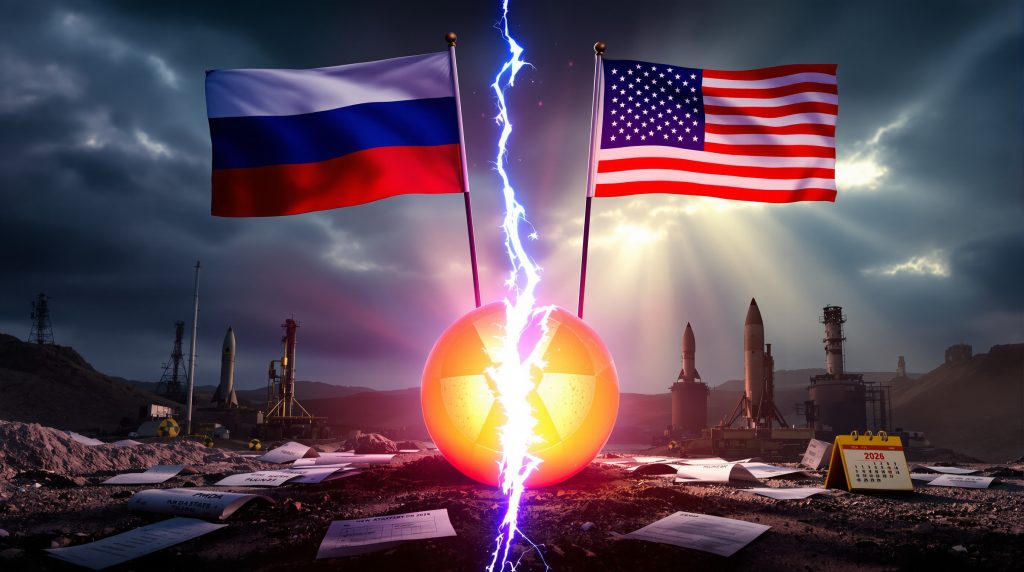Russia Withdraws from 25-Year-Old Weapons-Grade Plutonium Agreement
On October 8, 2025, the Russian State Duma officially approved withdrawal from the Plutonium Management and Disposition Agreement (PMDA), effectively ending Russian participation in this crucial nuclear arms control framework. This decision marks a significant setback for nuclear non-proliferation efforts and signals a further deterioration in U.S.-Russia relations. The collapse of this 25-year-old agreement removes yet another pillar from the increasingly fragile nuclear arms control architecture between the world's two largest nuclear powers.
What Was the Plutonium Management and Disposition Agreement?
The Plutonium Management and Disposition Agreement represented a landmark nuclear arms control initiative aimed at reducing the global stockpile of weapons-grade plutonium. Signed by Russia and the United States on September 1, 2000, in Moscow and entering into force on July 13, 2011, this bilateral agreement committed both nuclear powers to eliminate 34 metric tons of weapons-grade plutonium each—material sufficient to produce approximately 6,800-7,000 nuclear warheads.
The agreement established a framework for converting this dangerous material into a form unusable for weapons while harnessing its energy potential. Both countries initially committed to transforming the plutonium into mixed-oxide (MOX) fuel for civilian nuclear reactors, effectively repurposing material once designated for destruction into a resource for clean energy generation.
Beyond the technical aspects, the PMDA established rigorous verification protocols to ensure compliance. These included reciprocal inspection rights, detailed reporting requirements, and technical specifications for plutonium disposition. These verification measures were designed to build mutual confidence that neither party could easily reverse the disposition process and return the material to military use.
The agreement stood as one of the most significant post-Cold War achievements in nuclear security cooperation, demonstrating a shared commitment to irreversibly reducing nuclear weapons materials. It represented a practical implementation of the principle that both nations could enhance their security by mutually reducing excess nuclear materials.
Why Did Russia Withdraw from the Agreement?
Russia's decision to withdraw from the PMDA resulted from a combination of geopolitical tensions, technical disagreements, and divergent nuclear policy priorities. The official withdrawal announcement cited several specific justifications:
Deterioration of Broader Arms Control Framework
The PMDA's collapse occurs against a backdrop of disintegrating nuclear arms control architecture. The New START treaty, the last remaining major nuclear arms control agreement between Russia and the United States, is set to expire in February 2026 with no clear path to renewal. Both sides have expressed little optimism about reaching a new agreement amid heightened geopolitical tensions.
Additionally, mutual inspections under existing agreements have been frozen since 2023, creating an atmosphere of diminished trust and transparency. Russia suspended its participation in the New START treaty's implementation body in February 2023, while continuing to observe the treaty's numerical limits on deployed strategic warheads and delivery systems.
This broader context of eroding arms control mechanisms left the PMDA increasingly isolated as one of the few remaining bilateral nuclear security agreements, making it vulnerable to the deteriorating political relationship.
Disputes Over Disposition Methods
A fundamental technical disagreement emerged regarding plutonium disposition methods that ultimately proved irreconcilable. The original agreement specified conversion of weapons-grade plutonium into MOX fuel for civilian nuclear reactors, rendering it unusable for weapons while generating electricity.
However, the United States later shifted toward a "dilute and dispose" approach—mixing plutonium with inhibitor materials and burying it underground at the Waste Isolation Pilot Plant (WIPP) in New Mexico. This alternative approach was motivated largely by cost considerations, as the U.S. MOX facility at the Savannah River Site faced massive budget overruns, with projected costs ballooning from an initial $4.8 billion to over $17 billion.
Russia objected to this methodological change on several grounds:
- The buried plutonium remains chemically extractable, even if doing so would be difficult
- The approach violated the principle of irreversible transformation central to the agreement
- The isotopic composition of the plutonium would remain unchanged, unlike the reactor-based method
- Future technological advances might simplify recovery efforts
- The unilateral method change undermined the collaborative spirit of the agreement
These technical concerns reflected a deeper issue: Russia perceived the U.S. change in approach as undermining a core principle of the agreement—that plutonium disposition should be truly irreversible.
Claims of American Non-Cooperation
Russian officials characterized the withdrawal as a response to years of what they viewed as American non-cooperation. According to statements from the Russian Foreign Ministry, the Kremlin made repeated attempts to establish mutually agreeable plutonium utilization plans following the U.S. shift away from the MOX approach, but these proposals received inadequate engagement from Washington.
From Moscow's perspective, the agreement had become largely symbolic rather than substantive, with the United States pursuing its preferred disposition path unilaterally while technical discussions yielded no meaningful progress toward resolving differences.
How Did the Agreement Break Down Over Time?
The breakdown of the PMDA occurred gradually over several years, reflecting changing technical assessments, budget pressures, and evolving geopolitical realities:
Initial Implementation Challenges (2011-2016)
Following the agreement's entry into force in 2011, both countries began developing facilities to convert weapons-grade plutonium into MOX fuel. The United States initiated construction of a MOX Fuel Fabrication Facility at the Savannah River Site in South Carolina, while Russia pursued similar capabilities alongside developing its BN-600 and BN-800 fast neutron reactors, which could consume weapons-grade plutonium while generating electricity.
However, the U.S. MOX facility encountered significant problems almost immediately. By 2012, the projected cost had already increased to $7.7 billion from initial estimates of $4.8 billion, with completion dates pushed back several years. By 2016, cost projections had escalated to over $17 billion, with some estimates suggesting lifetime costs could reach $47.5 billion. Construction efficiency was also problematic, with the Government Accountability Office finding numerous management issues.
Russia, meanwhile, made more consistent progress with its plutonium disposition infrastructure. The BN-800 reactor at the Beloyarsk Nuclear Power Plant began commercial operation in October 2016, positioning Russia to fulfill its PMDA obligations using its preferred reactor-based approach.
U.S. Policy Shift (2016-2020)
Facing mounting costs and schedule delays, the Obama administration began exploring alternative disposition methods. In 2016, the Department of Energy formally proposed canceling the MOX project in favor of the "dilute and dispose" approach. This strategy involved oxidizing the plutonium, mixing it with inhibitor materials, and storing it at WIPP. The DOE estimated this alternative would cost $19.9 billion less than completing the MOX facility.
Russia immediately objected to this change. In October 2016, the Russian Foreign Ministry issued a statement noting that the alternative method "does not guarantee irreversible disposition" and "contradicts the spirit and letter of the PMDA." Despite these objections, the Trump administration continued pursuing the alternative approach, officially terminating the MOX project in 2018 when construction was approximately 70% complete.
The technical disagreement reflected fundamentally different priorities: While the United States focused on cost-effectiveness and timely implementation, Russia emphasized the irreversible transformation of the material and adherence to the original agreement terms.
De Facto Suspension Period (2020-2025)
While neither country formally withdrew from the agreement during this period, implementation effectively stalled. The United States continued developing its dilute and dispose strategy, initiating preparations for plutonium downblending and disposal at WIPP. Russia maintained that this approach violated the agreement's terms but did not immediately withdraw from the PMDA.
Bilateral discussions on resolving these differences yielded no progress. Technical working groups met sporadically but could not bridge the fundamental gap in perspectives regarding acceptable disposition methods. By 2023, with inspections under existing nuclear agreements suspended and diplomatic channels narrowing, the PMDA existed largely on paper with minimal practical implementation.
The final years before Russia's formal withdrawal were characterized by increasing frustration on both sides. Russian officials regularly cited the U.S. approach to plutonium disposition as an example of Western unreliability in arms control commitments, while U.S. officials emphasized pragmatic considerations of cost and feasibility.
What Are the Implications of Russia's Withdrawal?
Russia's withdrawal from the PMDA carries several significant implications for nuclear security, international relations, and non-proliferation efforts:
Erosion of Nuclear Arms Control Framework
The collapse of the PMDA represents another blow to the deteriorating nuclear arms control architecture. With the New START treaty expiring in February 2026 and negotiations for a replacement agreement stalled, the withdrawal removes yet another guardrail from the bilateral nuclear relationship. This continues a troubling pattern of disintegrating nuclear security agreements, following the collapse of the Intermediate-Range Nuclear Forces (INF) Treaty in 2019 and the effective end of the Open Skies Treaty in 2020.
The timing is particularly concerning given that both nations maintain large nuclear arsenals. According to the Federation of American Scientists, the United States currently deploys approximately 1,419 strategic nuclear warheads, while Russia deploys about 1,549, with combined stockpiles exceeding 12,000 warheads in total.
Without the PMDA's verification provisions, an important mechanism for transparency regarding weapons-grade material has been lost, potentially increasing uncertainty and mistrust between the nuclear powers.
Uncertainty Over Weapons-Grade Plutonium Disposition
The withdrawal creates uncertainty regarding the disposition of weapons-grade plutonium stockpiles. Both countries have substantial inventories of this material—the United States has declared a total plutonium inventory of 79.8 metric tons, while Russia is estimated to possess between 128-175 metric tons of weapons-grade plutonium.
While both countries will likely continue some form of plutonium management according to their national priorities, the absence of mutual verification and agreed disposition methods raises concerns about long-term security. The PMDA provided an important framework for ensuring that excess weapons material would be permanently removed from military programs. Without this framework, there are fewer international constraints on how this material is managed.
Signal of Deepening Strategic Rivalry
Russia's withdrawal sends a clear signal about the deepening strategic competition between Moscow and Washington. By formally ending participation in an agreement focused on irreversibly reducing nuclear weapons materials, Russia indicates a shift in its strategic calculus regarding cooperation with the United States on nuclear security matters.
This development aligns with broader trends in Russian strategic messaging, which has increasingly emphasized sovereignty and independence in security affairs. The withdrawal reinforces Russia's position that the post-Cold War cooperative security framework has fundamentally changed, with implications extending beyond nuclear issues to the broader international security architecture.
Potential Impacts on Global Non-Proliferation Efforts
The collapse of bilateral plutonium disposition efforts may complicate broader international non-proliferation initiatives. The agreement had served as a model for responsible management of weapons-grade materials, and its failure potentially undermines confidence in similar future arrangements.
The Non-Proliferation Treaty (NPT) system relies partly on demonstrable progress by nuclear weapons states toward disarmament. The PMDA's failure potentially undermines confidence in disarmament commitments and provides ammunition to critics who question the nuclear powers' commitment to their Article VI obligations under the NPT.
This setback comes at a particularly challenging time for the non-proliferation regime, as the most recent NPT Review Conference in 2022 failed to adopt a consensus document—only the second complete failure to do so in the treaty's history.
How Does This Fit Into the Broader Context of Nuclear Arms Control?
Russia's withdrawal from the PMDA represents part of a larger pattern of eroding nuclear arms control arrangements that have defined the post-Cold War security landscape:
Historical Context of Arms Control Agreements
The PMDA emerged from a period of relatively productive nuclear arms control efforts following the Cold War. Major achievements included:
- The Strategic Arms Reduction Treaty (START I) in 1991, which reduced deployed strategic warheads from approximately 10,000 each to 6,000
- The Cooperative Threat Reduction Program (Nunn-Lugar) in 1991, which provided U.S. assistance for securing former Soviet nuclear materials
- The Strategic Offensive Reductions Treaty (SORT) in 2003, requiring reductions to 1,700-2,200 deployed warheads
- The New START Treaty in 2010, limiting each side to 1,550 deployed strategic warheads
These agreements collectively reduced deployed nuclear weapons, established verification regimes, and created mechanisms for managing nuclear materials. The PMDA complemented these efforts by addressing the disposition of fissile material removed from weapons programs.
Recent Deterioration of Arms Control Framework
However, the past decade has witnessed a systematic unraveling of this framework:
- The U.S. withdrew from the Anti-Ballistic Missile Treaty in 2002
- The Intermediate-Range Nuclear Forces (INF) Treaty collapsed in 2019 after U.S. allegations of Russian violations
- The Open Skies Treaty effectively ended in 2020
- The New START Treaty faces expiration in February 2026 with no replacement in sight
- Nuclear Security Summits, which brought together over 50 nations to address nuclear security issues between 2010 and 2016, have not been continued
The PMDA withdrawal continues this troubling trend of diminishing cooperative mechanisms for managing nuclear risks. This deterioration reflects deeper changes in the international security environment, including increased great power competition, technological developments that challenge existing verification paradigms, and domestic political pressures in both countries.
Shifting Strategic Calculations
Both Russia and the United States appear to be recalibrating their approaches to nuclear arms control in response to changing strategic realities. Russia has emphasized that while arms control produced positive results in previous decades, current conditions have fundamentally changed. Russian strategic thinking increasingly emphasizes maintaining strategic deterrence capabilities amid what it perceives as a hostile security environment.
Similarly, U.S. policymakers have questioned the value of certain agreements in the contemporary security landscape. Budget pressures, concerns about verification, and the emergence of new technologies have all influenced American calculations about the costs and benefits of arms control arrangements.
These shifting strategic calculations reflect a broader transition from the immediate post-Cold War period, characterized by expectations of increasing cooperation, to a more competitive international system where nuclear weapons continue to play a central role in national security strategies.
What Happens to the Plutonium Now?
With the formal withdrawal from the PMDA, several questions arise regarding the disposition of weapons-grade plutonium previously covered by the agreement:
Current Status of Plutonium Stockpiles
Both countries maintain significant stockpiles of weapons-grade plutonium. The 34 metric tons each nation committed to eliminate under the PMDA represents only a portion of their total holdings:
- The United States has declared a stockpile of approximately 79.8 metric tons of plutonium (as of 2017), with about 38.2 metric tons designated as excess to defense needs
- Russia is estimated to possess 128-175 metric tons of weapons-grade plutonium, though Russia has not published official plutonium stockpile declarations since 2010
- Each metric ton of weapons-grade plutonium can produce approximately 150-200 nuclear weapons, highlighting the material's strategic significance
These materials remain subject to national security controls and safeguards, independent of the PMDA's status. Both nations maintain sophisticated physical security systems and material accounting procedures to prevent theft or diversion.
Ongoing Disposition Efforts
Despite the agreement's collapse, both countries are likely to continue some form of plutonium disposition efforts aligned with their national priorities:
- The United States will likely proceed with its dilute and dispose strategy, focusing on securing and storing plutonium at the Waste Isolation Pilot Plant in New Mexico
- Russia may continue its program to use plutonium in fast neutron reactors like the BN-800, which aligns with its broader nuclear energy development plans
- Both approaches will now proceed according to national timelines and priorities rather than internationally agreed schedules
However, without the PMDA's verification provisions, these efforts will proceed without mutual transparency or confidence-building measures. The absence of reciprocal inspections means each country will have limited visibility into the other's plutonium disposition activities.
Security Implications
The absence of mutual verification raises concerns about the security of weapons-grade plutonium. While both countries maintain sophisticated security systems for nuclear materials, the PMDA provided additional assurance through its verification regime. Its absence potentially increases uncertainty regarding the status and security of these materials.
The plutonium covered by the agreement will likely remain under strict national controls, but the international community will have reduced visibility into how this material is managed over time. This reduced transparency could potentially affect confidence in the broader non-proliferation regime.
What Are Expert Perspectives on the Withdrawal?
Nuclear security experts have offered varied assessments of Russia's withdrawal from the PMDA, reflecting different emphases on technical, strategic, and political factors:
Arms Control Community Concerns
Many arms control advocates view the withdrawal as a troubling development that further erodes the international security architecture. They emphasize several key concerns:
- The agreement provided important verification mechanisms for tracking weapons-grade materials that cannot easily be replaced
- Its collapse removes another layer of transparency from the U.S.-Russia nuclear relationship at a time when communication channels are already limited
- The timing, amid broader geopolitical tensions, signals diminishing prospects for future cooperation on nuclear risk reduction
- The erosion of formal agreements may increase the risk of misperception and miscalculation regarding nuclear postures
These experts typically emphasize that while the agreement had implementation challenges, its value as a framework for cooperation on nuclear security issues extended beyond the specific technical arrangements for plutonium disposition.
Strategic Analysts' Perspectives
Some strategic analysts frame the withdrawal as a logical response to changed circumstances in the bilateral relationship:
- The agreement had been effectively dormant for years, with fundamental disagreements over disposition methods rendering it largely symbolic
- Technical disputes over disposition methods reflected real differences in national priorities that proved difficult to reconcile
- Russia's formal withdrawal simply acknowledges the existing reality of non-implementation
- Both countries retain strong independent incentives to secure weapons-grade plutonium regardless of the agreement's status
This perspective emphasizes pragmatic considerations about the agreement's actual functioning rather than its symbolic importance, suggesting that its formal collapse may have limited practical impact given the pre-existing implementation challenges.
Technical Experts' Assessments
Technical experts have focused on the underlying dispute regarding disposition methods, noting important considerations about both approaches:
- The U.S. dilute and dispose approach offers cost advantages but does not change the isotopic composition of the plutonium
- Russia's reactor-based approach more definitively alters the material but requires significant infrastructure investment
- Both methods face implementation challenges, including waste management considerations, regulatory hurdles, and technical complexities
- Independent of the agreement, both countries have national security and environmental incentives to manage plutonium responsibly
These technical assessments highlight that while the agreement's collapse is concerning from a diplomatic perspective, the underlying challenge of plutonium management will continue to be addressed through national programs, albeit without international verification.
What Does This Mean for Future Nuclear Security Cooperation?
Russia's withdrawal from the PMDA raises questions about the future of nuclear security cooperation between the world's two largest nuclear powers:
Near-Term Prospects
In the immediate future, prospects for renewed cooperation appear limited by several factors:
- The broader geopolitical context remains challenging, with relations at their lowest point since the Cold War
- Trust between nuclear establishments has eroded significantly, complicating technical discussions
- Few channels remain for substantive exchanges on nuclear security issues
- Domestic political considerations in both countries create additional constraints on cooperation
These challenges suggest that in the near term, nuclear security efforts will likely proceed on parallel but separate tracks, with limited coordination or information sharing between the United States and Russia.
Potential Areas for Limited Engagement
Despite these challenges, certain areas may still offer opportunities for limited cooperation based on mutual interest:
- Nuclear security best practices and technologies to prevent unauthorized access to nuclear materials
- Prevention of nuclear terrorism and material smuggling, which threatens both countries
- Crisis communication mechanisms to prevent misunderstandings during nuclear alerts or incidents
- Multilateral forums where both countries participate, such as the International Atomic Energy Agency
These areas represent potential starting points for rebuilding technical dialogue, even if more ambitious arms control efforts remain stalled. They focus on shared concerns where cooperation provides clear benefits to both parties.
Long-Term Considerations
Looking further ahead, several factors may influence the trajectory of nuclear security cooperation:
- The evolution of the broader strategic relationship between Russia and the United States, which will shape the political context for technical cooperation
- Domestic political developments in both countries, including leadership changes and shifts in nuclear policy
- The emergence of new nuclear security challenges that may create incentives for collaboration
- The role of third parties, including China, in shaping the nuclear security landscape
Historical experience suggests that even during periods of significant tension, pragmatic cooperation on reducing nuclear dangers has sometimes remained possible. The challenge will be identifying areas where mutual interest can overcome political obstacles to engagement.
How Does This Affect Global Nuclear Non-Proliferation Efforts?
The collapse of the PMDA has implications beyond the bilateral U.S.-Russia relationship, potentially affecting global efforts to prevent the spread of nuclear weapons:
Impact on the Non-Proliferation Treaty (NPT) Regime
The NPT system relies partly on demonstrable progress by nuclear weapons states toward disarmament. The PMDA's failure potentially undermines these efforts in several ways:
- It may be perceived as reducing commitment to Article VI obligations, which require good-faith efforts toward disarmament
- It provides ammunition to critics who question whether nuclear weapons states are fulfilling their treaty obligations
- It complicates messaging at future NPT review conferences, where progress on disarmament is a key topic
The timing is particularly challenging given that the most recent NPT Review Conference in 2022 failed to adopt a consensus final document, highlighting existing strains in the non-proliferation regime.
Influence on Other Nuclear Materials Initiatives
The agreement's collapse may affect other international efforts to secure nuclear materials:
- It potentially weakens the normative framework for irreversible disposition of weapons materials
- It raises questions about verification approaches for future agreements on fissile material
- It may complicate multilateral initiatives on fissile material controls, such as discussions of a Fissile Material Cut-off Treaty
- It could affect international confidence in bilateral commitments regarding nuclear materials
These effects extend beyond plutonium to broader questions about how weapons-usable nuclear materials are managed internationally, potentially complicating efforts to develop new frameworks for material security.
Lessons for Future Agreements
The PMDA experience offers important lessons for designing future nuclear security arrangements:
- Technical approaches must be realistic, affordable, and adaptable to changing circumstances
- Verification provisions should be robust yet flexible enough to accommodate implementation challenges
- Agreements should anticipate changing technological and political circumstances
- Economic and financial considerations deserve careful attention during initial negotiations
- Dispute resolution mechanisms are essential for managing inevitable disagreements
These lessons may inform approaches to future agreements, emphasizing practical implementation considerations alongside diplomatic and strategic objectives.
What Are the Technical Aspects of Plutonium Disposition?
Understanding the technical aspects of plutonium disposition provides important context for the agreement's collapse and the challenges of managing these materials:
Weapons-Grade Plutonium Characteristics
Weapons-grade plutonium (typically >93% Pu-239) has specific properties that make its disposition challenging:
- Half-life of approximately 24,110 years, requiring long-term management solutions
- Highly toxic if ingested or inhaled, with significant radiation hazards
- Requires specialized handling and security measures to prevent diversion
- Critical mass of 10-13 kg (bare sphere) or as little as 4-5 kg (with reflector)
- Specific activity of 2.3 GBq/kg, presenting significant radiological concerns
These characteristics create technical challenges for any disposition approach, requiring careful management of both security and environmental risks over long time periods.
MOX Fuel Approach
The original PMDA emphasized converting plutonium into mixed-oxide (MOX) fuel:
- Weapons-grade plutonium would be blended with uranium oxide to create fuel containing 5-10% plutonium dioxide
- The resulting fuel would be fabricated into pellets, loaded into fuel rods, and used in civilian nuclear reactors
- During irradiation in reactors, the isotopic composition changes, creating plutonium unsuitable for weapons use
- After use, the spent fuel would contain plutonium in a form protected by high radiation fields
- This approach would generate electricity while eliminating weapons material
The MOX fuel production process involves multiple technical steps, including plutonium dioxide powder production, blending with uranium dioxide, pellet fabrication through pressing and sintering, loading into zircaloy fuel rods, and fuel assembly construction.
Dilute and Dispose Approach
The alternative U.S. approach involves different technical processes:
- Converting metallic plutonium to oxide form
- Mixing plutonium with inhibitor materials that complicate extraction
- Packaging the mixture in secure containers designed for long-term storage
- Storing these containers in the Waste Isolation Pilot Plant, a deep geological repository 655 meters underground in a salt formation in New Mexico
- Relying on physical security rather than isotopic changes to prevent reuse
This approach leverages existing waste management infrastructure but does not alter the fundamental nature of the plutonium, leading to Russian uranium import ban objections about its reversibility.
Technical Disagreements
The fundamental technical disagreement centered on whether the dilute and dispose method met the agreement's requirement for irreversible transformation. Russia maintained that:
- The plutonium remains chemically extractable, even if doing so would be difficult and expensive
- The approach fails to change the isotopic composition of the plutonium, unlike reactor irradiation
- Future technological advances might simplify recovery efforts
- The geological barriers, while significant, do not provide the same level of irreversibility as isotopic changes
These technical concerns reflected different philosophical approaches to plutonium disposition: the U.S. emphasized cost-effectiveness and timely implementation, while Russia prioritized irreversible transformation of the material.
Conclusion: The Future of Nuclear Materials Security
The collapse of the PMDA highlights the challenges of sustaining nuclear security cooperation amid broader strategic competition. While the agreement's formal end marks a significant setback for bilateral arms control, both countries retain strong independent incentives to secure weapons-grade plutonium.
The withdrawal occurs at a particularly challenging moment for the international nuclear security architecture, with multiple agreements having collapsed or facing uncertain futures. This trend reflects deeper shifts in the international security environment, including increased great power competition and changing technological realities.
Despite these challenges, the fundamental objective of preventing nuclear materials from falling into unauthorized hands remains as important as ever. Both countries will continue plutonium management efforts according to their national priorities, though without the transparency and confidence-building measures the PMDA provided.
The path forward likely involves:
- Maintaining robust national systems for securing nuclear materials
- Preserving technical dialogue where possible, even amid political tensions
- Identifying pragmatic, limited areas for cooperation on shared nuclear security concerns
- Developing new approaches to verification that can function in a more competitive environment
As the international community navigates this challenging landscape, the experience of the PMDA offers important lessons about the technical, political, and strategic dimensions of nuclear waste safety. The withdrawal underscores that effective nuclear security cooperation requires not just technical solutions but also sustained political commitment and adaptability to changing circumstances.
The uranium mining halt and subsequent uranium market volatility seen in recent months, combined with the US uranium production order have all contributed to a complex and challenging nuclear security landscape that will require innovative approaches to navigate successfully.
According to Russia's official statement on withdrawing from the Cold War plutonium deal, the decision was framed as a response to "unfriendly actions" by the United States. This narrative highlights how technical disagreements have become entangled with broader geopolitical tensions.
Want to Know the Next ASX Discovery Before the Market Does?
Discovery Alert's proprietary Discovery IQ model identifies significant ASX mineral discoveries in real-time, providing actionable insights for savvy investors. Visit the Discovery Alert discoveries page to see how major mineral finds can generate exceptional returns and position yourself ahead of the market.




